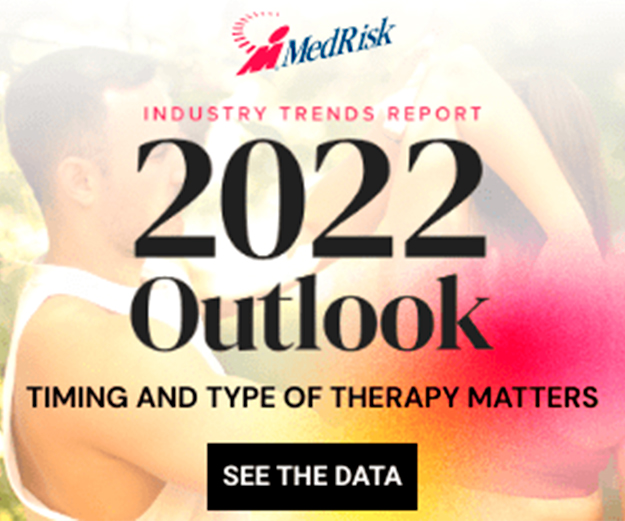
Apr 25, 2024 | Insights
Early PT can be the key to improved injured worker outcomes and lower claims costs. How can workers’ comp promote quicker access to care?

Any sports fan can probably recall a moment when they saw a professional athlete get injured on the field. A wide receiver limps off the field grabbing his hamstring. A basketball player sprains his ankle. An outfielder nurses his shoulder on the way to the dugout.
For common musculoskeletal sprains, strains and similar injuries, athletes will be in PT almost as soon as they’re off the court — getting them back to full health and function will be top priority for their teams.
That immediate access to PT has proven results, and it’s caused some in the workers’ compensation industry to wonder what would happen if injured workers got that kind of care. After all, a professional athlete is also just a worker doing a job.
“What’s the difference for an industrial athlete that is working in a coal mine and a professional athlete that’s on a football field?” said Greg Nichols, PT, president of SPNet, a division of MedRisk. “They’re still trying to make a living for their family.”
A growing body of evidence suggests that fast and direct access to PT improves outcomes for injured workers and can reduce claims costs. Now, new technologies are helping payers and their PT partners catch potential claims hurdles earlier and improving communication throughout the workers’ comp process.
A Growing Emphasis on Early Access to PT

Greg Nichols, President of SPNet, A MedRisk company.
The broader U.S. health care system has long known the benefits of early PT. A study from the U.S. Department of Defense found that seeing a physical therapist resulted in $3.6 million in reduced medical spending and improved patient outcomes.
“There’s this accumulation of evidence that points towards the benefits of starting the rehab process early,” said Brian Peers, DPT, MBA, vice president of provider management and clinical services at MedRisk.
“It seems to be independent of the body part, the age, the job type, the type of injury, the severity. Across the board, earlier access to rehabilitation is translating to better outcomes — not just clinically but also as far as the claim outcome goes.”
Other studies have found that PT can reduce costs and improve outcomes for a variety of common workers’ compensation injuries. MedRisk’s 2024 trend report found that when PT is used over alternative treatments, payers can see $39,533 in net economic savings for carpal tunnel and $4,160 for low back pain.
The key here: direct patient access. Rather than seeing a primary care physician or a chiropractor first, patients went directly to a PT, as many patients in the Department of Defense study had immediate access to a PT, much like a professional athlete. They didn’t spend time seeing other providers or working through the workers’ compensation system.
Simply put: “If someone needs physical rehabilitation, let’s get them in physical rehabilitation as soon as we can,” Peers said.
Access to quick and conservative medical care like physical therapy is obviously important to improving claims outcomes. Workers’ comp payers and providers need to work together to get injured workers the care they need. Yet speed-to-care in workers’ comp has only increased by about 2% over the past 10 years, per MedRisk’s 2024 injury trends report.
“If the injured worker is struggling to enter into the medical ecosystem, we’ve got to create another entry point somewhere,” Nichols said. “If we don’t have clear channels of communication with these injured workers, then we’re dropping the ball.”
How Does Early PT Drive Improved Patient Outcomes?

Brian Peers, DPT, MBA, Vice President of Provider Management and Clinical Services, MedRisk
In order to get the workers’ compensation industry to embrace early access to PT, it needs to understand the benefits. The studies are clear. “We’re seeing people getting back to work faster. We’re seeing lower expense for the claim overall,” Peers said — but it’s important to know why that’s the case.
So, why is early PT so critical to driving positive claims outcomes?
One component is physical. Early access to care can prevent injuries from getting worse and requiring surgery or other costly treatments down the road. “We want to get these folks started as early as we can because we know that the outcomes will be better,” Peers said.
But the benefits of early PT go beyond physical health improvements. Physical therapists spend significant amounts of time with injured workers. They can detect changes in mood, like depression or anxiety, or flag other biopsychosocial factors that could influence a claim before it derails recovery and drives up costs.
“What we’re starting to learn about is the value of the interaction between the PT provider and the claimant to pick up on barriers that might exist but are buried underneath the surface,” Peers said.
New technologies are helping PTs share these insights with adjusters and other stakeholders; data-driven models are helping to process the information and create recovery models to help predict claim progress. All these factors contribute to quicker return-to-work timelines and lower claims costs.
“TPAs had a bunch of information regarding a claimant, and it would have been great if we were passing that information on to the PT provider early,” said Skip Brechtel, executive vice president of strategic partnerships, CCMSI.
“Clinicians were gleaning all of this information, literally talking to the claimant significantly more in the early stages than an adjuster does. Having that information enhances what we can do to better move along in that claim.”
A Collaborative, Data-Driven Approach

Skip Brechtel, Executive Vice President of Strategic Partnerships, CCMSI
The benefits of early PT — for patient outcomes, for claims costs — are unambiguous. Injured workers get the treatment they need sooner and claims costs are reduced.
MedRisk has long been a leader in providing workers’ compensation PT services. Last year, the company treated over half a million injured workers, and 90% of workers’ comp payers choose MedRisk for managed PT services.
The company has invested in a number of innovative tools to help capture and process claims data so providers and adjusters can effectively use it to drive recovery. Its tools can help process unstructured claims data, like the data gleaned from interviews, so it can be processed and used to drive better recovery outcomes.
“It takes all these things and it scores the claim,” Brechtel said. “You’re capturing significantly more information on that claimant.”
Most important of all, MedRisk understands that workers’ comp is a collaborative business with many stakeholders. It understands the importance of working with health care providers, insurers and other stakeholders to ensure the best possible care for injured workers.
“One party can’t do it alone,” Brechtel said. “It’s got to be all three working in unison.
All in all, MedRisk helps injured workers get the physical therapy they need, when they need it.
“We have a lot of musculoskeletal injuries,” Peers said. “We have this mounting data that’s getting better at predicting who needs what and when, and what’s effective and what’s not working. But we still, as an industry, have to get better at delivering the right care to the right person at the right time to get these outcomes.”
Oct 3, 2023 | Insights
Remarkable technologies entering the market could radically transform claims management in workers’ compensation. These revolutionary innovations include natural language processing, virtual reality, cost-effective sensors, intricate reporting mechanisms, and especially artificial intelligence or AI.
Last week’s Leaders Speak article stressed the need to remain focused on patient outcomes while navigating the age of AI. Organizations must be careful not to fall prey to the “shiny object syndrome” by simply plugging in technology to solve a problem that isn’t even there. They need to carefully examine the technology’s ability to positively affect the company’s workflow and the patient’s outcomes.
Answering the important questions posed in last week’s article will help you determine if a particular technology indeed aligns with your mission. This week, we delve deep into the next three steps that can improve the implementation, and more importantly, adoption and user satisfaction with the AI tool.
Staying mindful of biases and their potential impact
When harnessing the power of AI, it is imperative to acknowledge and address the inherent issue of bias that can permeate its outcomes. The foundation for AI predictions rests upon the data it processes, underscoring the importance of curating a robust and representative dataset. Thus, the quality of the dataset used for training the AI engine directly influences the accuracy and fairness of the AI’s conclusions.
Just as our biases subtly influence the instructions given to children, biases that may be present in our training data also have the potential to infiltrate future results, leading to biased AI predictions. It then becomes paramount to remain cognizant of these biases and their potential impact on AI systems. And while complete eradication of bias is impossible, fostering awareness enables us to take proactive measures.
Furthermore, efforts should be dedicated to not only identifying biases but also mitigating their effects. Ensuring transparency and accountability in the AI development process is essential. It is incumbent upon developers to comprehensively assess their datasets, identify potential sources of bias, and implement corrective measures. By meticulously scrutinizing the training process and using curated synthetic data sets, companies can minimize unjust prejudices and bolster AI’s functionality.
Designing with the end user in mind and facilitating meaningful interaction
As with any new processes and technology, AI adoption often faces resistance, particularly among experienced professionals who believe their judgment supersedes automated systems. This is especially evident in the realm of workers’ compensation, where adjusters’ expertise is highly valued. Crafting AI solutions with the end users in mind then requires a thoughtful approach to overcome the initial skepticism and ensure meaningful adoption.
A strategy to encourage adoption is to design AI interactions that can dialogue with claims managers similar to the way adjusters consult with each other on complex cases. A well-designed AI can engage adjusters in a Q&A dynamic where context is supplemented and personalization is prioritized. Here, AI’s role is a collaborative one, allowing adjusters to query AI about predictive drivers for the injury, or request examples of similar cases to broaden their insights.
When claims managers can pose questions, refine queries, and draw on AI’s rich bank of information, AI becomes a conversational partner and a rich research resource instead of a mere prediction engine. This collaborative approach breaks down barriers to acceptance. Instead of replacing human expertise, AI complements it by taking that gut feeling adjusters develop over time, systemizing it, and scaling it.
Contextualizing outcomes as a supplementary tool
AI undoubtedly has the potential to serve as a valuable addition to our toolset, complementing existing interventions and enhancing the diligence and effectiveness of our operations. Its power lies in aggregating accumulated knowledge and insights to drive informed choices and decision-making.
All things considered, however, employing AI also demands a nuanced perspective. It’s crucial to avoid absolute judgments – AI isn’t inherently right or wrong. It is also neither the end-all and be-all nor a one-size-fits-all solution, and users must steer clear of blind adherence to AI-generated responses. After all, no two cases are exactly the same and results must be contextualized within the appropriate actions. Moreover, it’s important to break down informational silos within an organization and across stakeholders to improve communication and data-sharing in order to maximize results
Striking harmony between the use of AI and a patient-first ethos
Ultimately, the successful integration of AI within the workers’ compensation industry hinges on three crucial considerations that form the cornerstone of our approach: staying acutely mindful of biases and their potential impact on outcomes, designing solutions to foster meaningful interactions, and using AI-generated results as a supplementary tool in driving outcomes.
At the end of the day, our ethos is patient-first, not AI-first, and our primary purpose is to guide patients back to work safely post-injury. Remaining steadfast in this mission, however, should not preclude us from embracing transformative technologies. And as we navigate this new AI-driven landscape, our perspective should extend beyond mere technology adoption and more towards strategically employing AI to influence better outcomes across the patient journey.
Three Key Considerations for the Successful Integration of AI in Workers’ Comp. WorkCompWire.com, https://www.workcompwire.com/2023/09/sandip-chatterjee-three-key-considerations-for-the-successful-integration-of-ai-in-the-workers-compensation-industry/.
Oct 3, 2023 | Insights
In the “age of AI,” how do we stay focused on our fundamental objectives and leverage technological advancements in achieving them?
Today’s rapidly advancing environment has introduced our industry to the wonders of groundbreaking technology such as artificial intelligence (AI), sensors, virtual reality (VR) headsets, and natural language processing (NLP) capabilities. These developments have grown so rapidly over the last few years that we find ourselves in what we could call “the age of AI,” presenting us with a multitude of opportunities for prediction, automation, and other tools.
But while these new technologies all promise to revolutionize how we do things, it’s important to never lose sight of our core purpose: patient recovery. Yes, these innovations present immense potential to improve patient care, but we must be careful not to fall victim to the “shiny object syndrome,” the allure of adopting the latest technology without a clear understanding of its alignment with our industry’s core mission.
Staying grounded in our collective mission and identifying opportunities for genuine improvement
The journey of patient recovery is central to every decision and strategy within the physical therapy (PT) industry and our core purpose should always be helping each patient safely return to work following an injury. With this in mind, we begin to look for areas where we can do things better and then look for tools that can help. It is from here that we take a pause and ask, “to what end?” Before embracing the next technological innovation, we must first understand if and how it enables patient compliance between treatments, measures progress in recovery, and promotes safe behaviors that prevent future injury.
Maximizing the value from insights
There is a wealth of data to be mined within the PT industry. We gather valuable information on providers, injuries, and treatment patterns from each case we manage. In addition to what we gather today, the PT industry is also inundated with numerous digital musculoskeletal solutions, each claiming to deliver unprecedented insights. However, regardless of the volume, data are of little use unless we are able to apply them to our purpose.
Technologies like NLP have made it easier to derive meaningful insights from vast volumes of data. Predictive AI models are helping us spot patterns across cases more quickly and, ultimately, make the right plays earlier on.
Aligning technology with the North Star of patient recovery
The vast expanse of technological innovation should always be navigated by our North Star: patient recovery. Will it enhance the patient’s experience? Does it have the potential to save us time and reduce costs? Can it bridge a significant gap or address a pain point that’s crippling the ability to provide effective and efficient care? Will it simplify a complex process or will its implementation only further complicate things?
Before embracing the latest trends, it is critical to meticulously evaluate any new “shiny object” against these questions.
While technological advancements offer incredible potential, they must always be deliberately aligned with the objective of improving patient outcomes. By staying grounded in the purpose of the workers’ compensation industry, we unlock the ability to leverage technology effectively and create a future where patient recovery remains at the forefront of every decision and strategy.
Navigating the Age of AI with Purpose. WorkCompWire.com, https://www.workcompwire.com/2023/09/sri-sridharan-navigating-the-age-of-ai-with-purpose/.








